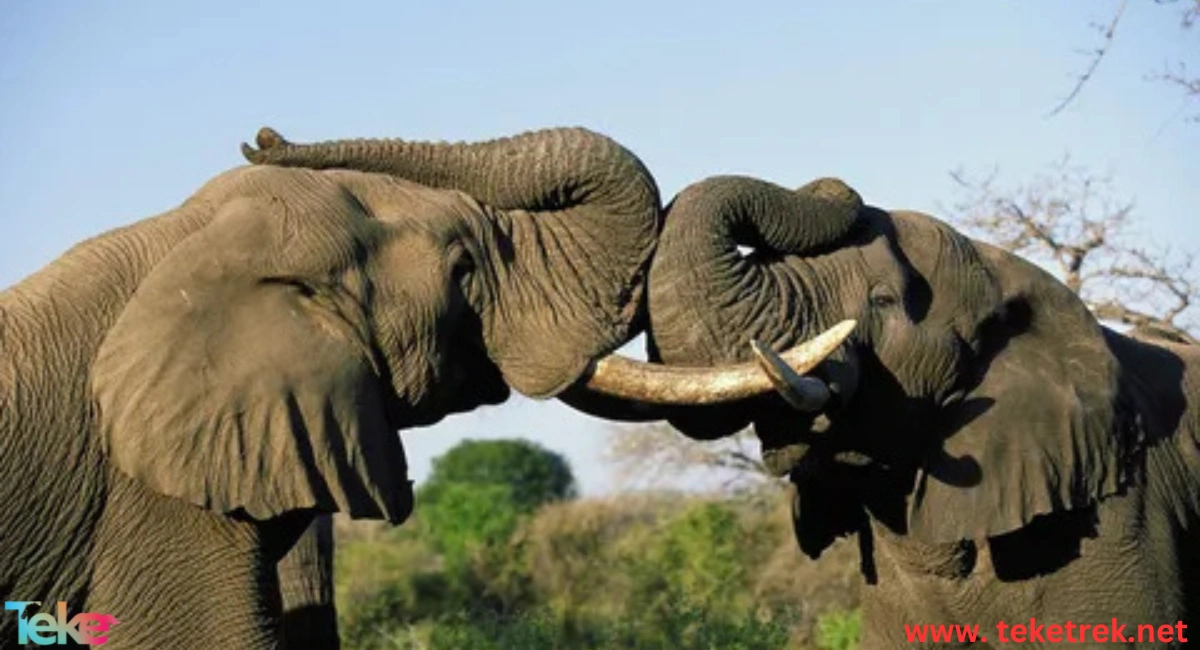Elephants are gentle wild animals that do not harm humans. They are fascinating and intelligent creatures known for their social behavior and preference for living in groups. They communicate with each other in various ways, including tactile signals, body language, and vocalizations. Researchers, especially those who care for elephants in sanctuaries and captivity, study and seek to understand how these animals interact. Elephants are highly emotional beings; they can express happiness and sorrow and have strong bonds with their families, mourning the loss of a member، Here are the details from teketrek.
Different Ways Elephants Use to Communicate
Scientists have discovered that elephants use over 30 different vocalizations to communicate. Some of these sounds, like low-frequency rumbles, are inaudible to the human ear, while others are loud and can be heard from miles away. Elephants also produce sharp barking sounds to express emotions such as warning signals or distress, allowing them to engage in social interactions and maintain strong ties within the herd.
Elephants also use body language for communication, including ear movements, trunk gestures, and overall body posture. For instance, extended ears indicate excitement or agitation, while folded ears show submission or fear. Trunks are used for affection, play, or discipline within the herd.
Another form of communication among elephants is chemical signaling. They leave scent marks through urine, dung, and glandular secretions to inform others about their reproductive state or the presence of nearby water sources.

The Role of Deep Sounds and Vibrations in Elephant Communication
Elephants produce a range of sounds with frequencies between 27 to 470 Hz, each serving a specific purpose. Here are some of the main sounds and their roles:
- Trumpeting: Elephants produce this sound when swimming or playing, often associated with excitement and social interactions. It is created by expelling air through the trunk while spraying water.
- Rumbling: A deep, low-frequency sound used for long-distance communication, greetings, reassurance, and courtship. It is often too low for human ears to detect.
- Roaring: Elephants roar when they feel threatened by predators, need help, or express extreme anger or distress. It can also indicate joy.
- Squeaking: A high-pitched sound used to convey news, call the herd for meetings, or signal that danger has passed.
- Ear Flapping: When elephants flap their ears, it creates a sound that signifies relaxation and comfort.
- Bubbling: A well-known elephant sound similar to loud screaming, used to express excitement or anger. It can be heard from great distances and serves as a warning or an alert to attract attention.
How Do Elephants Use Body Language for Communication?
Elephants do not rely solely on vocalizations; they also use body language to communicate. They express emotions through tactile gestures, such as touching each other with their trunks, ears, tusks, or trunks, to show affection, comfort, or support. Trunks are also used to explore objects and search for food.
An elephant standing tall with spread ears signals aggression, while a female elephant may show interest in a male by nodding her head back and forth. Elephants also use their tails, ears, and tusks to express emotions like excitement or hostility. Their feet secrete scents that serve as messages for the rest of the herd, and they can release odors from glands on the sides of their heads.
Characteristics and features of the Nubian giraffe and interesting facts about it
Do Elephants Have Strong Memories That Help Them Communicate?
Elephants have some of the largest brains among mammals, giving them exceptional memory. They can remember humans they have encountered and recognize fellow elephants even after many years. Their strong memory allows them to communicate through vocal, body, and chemical signals. Studies even suggest that elephants can call each other by unique names.

Fascinating Facts About Elephant Communication
The world of elephants is full of wonders and surprises. Here are some incredible facts about their communication:
- Elephants have excellent hearing thanks to their large ears and can detect sounds from long distances that humans cannot hear.
- They can warn the herd of seismic vibrations from great distances.
- Elephants are the only animals that communicate through touch, sight, and body movements.
- They can detect the scent of other elephants from far away using their powerful sense of smell.
- They use their sense of smell to locate food, water, and detect threats.
- Elephants are skilled swimmers; they paddle using their legs and keep their bodies afloat while using their trunks as snorkels.
Conclusion
Elephants are incredibly intelligent and wise animals with unique ways of communicating that humans may never fully understand. Their use of body language, silent conversations, chemical signals, and complex vocal expressions makes them stand out from other animals. They can convey emotions like joy, sorrow, and anger, making their interactions highly sophisticated. The world of elephants is truly astonishing and full of mysteries!





